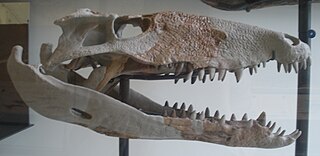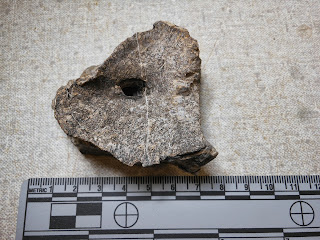The mystery of the 'mystery bone" has been solved - it definitely is the skull with teeth in place in the upper jawbone!
The big bone we've been chasing out for over a month is definitely the skull of the animal. Just Wednesday (9/25/13) we uncovered three, possibly 4 teeth in place in the end of the upper jaw. Uncovering the others will need to be done under a 15 power scope as it's just too nerve-wracking to try to do it with a 3 power head-mounted magnifier. This is because the teeth are the exact same color and texture as the small chips of chert common in the matrix, and you can't tell the difference without significant magnification. So we'll rig up the boom microscope over the big block and go for it next week.
The smaller pointed bone to the right of the snout is a neural arch, not part of the skull bone. It looks like the skull is mostly intact (the right side, at least) although the snout is broken it is nearly in position. It appears to be quite broad toward the back, over 200mm (8 inches) wide as over 50mm are already exposed and we're somewhere toward the mid-line of the skull. It's about 300mm (12 inches) long as exposed. It will take us several months to get the skull out, as there is lots of rock to pulverize and remove to get it out. A nice Christmas present maybe.
Stepping back from the excitement, this skull and the other bones, taken as a whole, present a great dilemma and discovery. The skull does not look like an Ichthyosaur - more like a crocodylomorpha (triassic crocodile ancestor) It has relatively small eyes. I'm not sure which hole is the orbit (eye socket), but it looks like the closed hole in the middle is the best guess, and the curved arc in the back would be the rear of the skull. Whichever hole it is, this animal did not have large eyes like Ichthyosaurs. The shape of the skull is more like Croc. The arm ones are long, again more like a Croc than an Ichthyosaur. Countering this, the backbones and ribs are very much like an Ichthyosaur, not at all like a Croc. There are no scutes (ostoderms) - bony plates armoring the skin of Croc. The teeth are like an Ichthyosaur. We probably don't have two mixed skeletons. All the visible backbones on all the blocks (not just this first block) are like Ichthyosaurs. My guess at this point in time is that we have a new, very basal Ichthyosaur showing many characteristics of ancestors less adapted to fully marine life. On the other hand, it may be a marine Crurotarsans, or very early sea-crocodile like Thalattosuchis, although they are known from the Jurassic and Cretaceous. This would be earlier than that, as it's Triassic!
Quoting from Wikipedia "Thalattosuchia is the name given to a clade of marine crocodylomorphs from the Early Jurassic to the Early Cretaceous that had a cosmopolitan distribution. They are colloquially referred to as marine crocodiles or sea crocodiles, though they are not members of Crocodilia."
Here's a triassic Sebecus icaeorhinus -Crocodylomorpha - some simularities are obvious.
Quoting from Wikipedia "Thalattosuchia is the name given to a clade of marine crocodylomorphs from the Early Jurassic to the Early Cretaceous that had a cosmopolitan distribution. They are colloquially referred to as marine crocodiles or sea crocodiles, though they are not members of Crocodilia."
Here's a triassic Sebecus icaeorhinus -Crocodylomorpha - some simularities are obvious.

Here's an animation taken from still photographs showing the skull excavation. It shows the block before any of the skull was exposed and ends up with the above large picture. I've had to make it small to be uploaded, it's still 80 megs so please be patient.
Stay tuned for more updates. I'll be posting about the 'tools' of the trade soon, telling you how we actually do the preparation.
Sincerely, Greg Carr
Sincerely, Greg Carr










